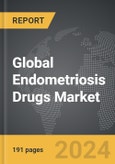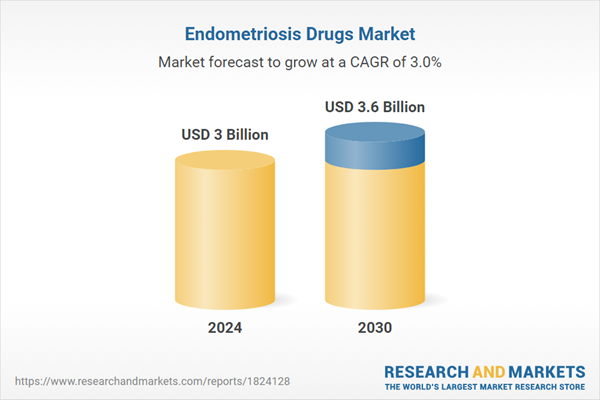The global market for Endometriosis Drugs was valued at US$3.0 Billion in 2024 and is projected to reach US$3.6 Billion by 2030, growing at a CAGR of 3.0% from 2024 to 2030. This comprehensive report provides an in-depth analysis of market trends, drivers, and forecasts, helping you make informed business decisions. The report includes the most recent global tariff developments and how they impact the Endometriosis Drugs market.
Several trends are shaping the landscape of endometriosis drug development and treatment. One significant trend is the growing focus on personalized medicine, where treatments are tailored to the individual’s specific genetic, hormonal, and symptomatic profile. This approach is gaining traction as researchers uncover more about the underlying mechanisms of endometriosis, leading to the development of targeted therapies that promise greater efficacy and fewer side effects. Additionally, there is an increasing interest in non-hormonal treatments due to the side effects and contraindications associated with long-term hormonal therapy. Innovations in this area include drugs that target the inflammatory pathways and pain receptors specific to endometriosis. Furthermore, advancements in diagnostic tools, such as molecular imaging and biomarker identification, are improving early detection and monitoring of the disease, allowing for more timely and effective intervention.
The growth in the endometriosis drugs market is driven by several factors. Technological advancements in drug discovery and development are enabling the creation of novel therapies with improved safety and efficacy profiles. The increasing prevalence of endometriosis, coupled with heightened awareness and better diagnosis rates, is expanding the patient population requiring treatment. Additionally, the shift towards personalized and precision medicine is fostering the development of customized treatment plans that cater to the unique needs of each patient, enhancing therapeutic outcomes. The demand for non-hormonal treatment options is also propelling market growth, as these alternatives offer solutions for patients who cannot tolerate hormonal therapies. Furthermore, substantial investments in research and development by pharmaceutical companies, along with supportive government initiatives and funding for women's health, are accelerating the introduction of new and effective endometriosis treatments. These combined factors are driving robust growth in the endometriosis drugs market, meeting the urgent needs of affected women worldwide.
Segments: Product Type (Hormone therapy, Analgesics).
Geographic Regions/Countries: World; United States; Canada; Japan; China; Europe (France; Germany; Italy; United Kingdom; and Rest of Europe); Asia-Pacific; Rest of World.
The analysts continuously track trade developments worldwide, drawing insights from leading global economists and over 200 industry and policy institutions, including think tanks, trade organizations, and national economic advisory bodies. This intelligence is integrated into forecasting models to provide timely, data-driven analysis of emerging risks and opportunities.
Endometriosis Drugs - Key Trends and Drivers
Endometriosis is a chronic gynecological condition characterized by the growth of endometrial-like tissue outside the uterus, causing severe pain, irregular bleeding, and infertility. Managing this condition often requires a multifaceted approach, including surgical intervention and pharmacological treatment. Endometriosis drugs primarily aim to alleviate pain, reduce inflammation, and manage the hormonal imbalances associated with the disease. The most commonly prescribed medications include nonsteroidal anti-inflammatory drugs (NSAIDs) for pain relief, hormonal contraceptives to regulate menstrual cycles, and gonadotropin-releasing hormone (GnRH) agonists and antagonists to lower estrogen levels and shrink endometrial tissue. Other treatments involve progestins, which mimic the hormone progesterone to suppress endometrial growth, and aromatase inhibitors, which reduce estrogen production. These therapeutic strategies are critical in providing symptom relief and improving the quality of life for women suffering from endometriosis.Several trends are shaping the landscape of endometriosis drug development and treatment. One significant trend is the growing focus on personalized medicine, where treatments are tailored to the individual’s specific genetic, hormonal, and symptomatic profile. This approach is gaining traction as researchers uncover more about the underlying mechanisms of endometriosis, leading to the development of targeted therapies that promise greater efficacy and fewer side effects. Additionally, there is an increasing interest in non-hormonal treatments due to the side effects and contraindications associated with long-term hormonal therapy. Innovations in this area include drugs that target the inflammatory pathways and pain receptors specific to endometriosis. Furthermore, advancements in diagnostic tools, such as molecular imaging and biomarker identification, are improving early detection and monitoring of the disease, allowing for more timely and effective intervention.
The growth in the endometriosis drugs market is driven by several factors. Technological advancements in drug discovery and development are enabling the creation of novel therapies with improved safety and efficacy profiles. The increasing prevalence of endometriosis, coupled with heightened awareness and better diagnosis rates, is expanding the patient population requiring treatment. Additionally, the shift towards personalized and precision medicine is fostering the development of customized treatment plans that cater to the unique needs of each patient, enhancing therapeutic outcomes. The demand for non-hormonal treatment options is also propelling market growth, as these alternatives offer solutions for patients who cannot tolerate hormonal therapies. Furthermore, substantial investments in research and development by pharmaceutical companies, along with supportive government initiatives and funding for women's health, are accelerating the introduction of new and effective endometriosis treatments. These combined factors are driving robust growth in the endometriosis drugs market, meeting the urgent needs of affected women worldwide.
Report Scope
The report analyzes the Endometriosis Drugs market, presented in terms of units. The analysis covers the key segments and geographic regions outlined below.Segments: Product Type (Hormone therapy, Analgesics).
Geographic Regions/Countries: World; United States; Canada; Japan; China; Europe (France; Germany; Italy; United Kingdom; and Rest of Europe); Asia-Pacific; Rest of World.
Key Insights:
- Market Growth: Understand the significant growth trajectory of the Hormone therapy segment, which is expected to reach US$2.2 Billion by 2030 with a CAGR of a 3.3%. The Analgesics segment is also set to grow at 2.6% CAGR over the analysis period.
- Regional Analysis: Gain insights into the U.S. market, valued at $822.9 Million in 2024, and China, forecasted to grow at an impressive 2.9% CAGR to reach $580.1 Million by 2030. Discover growth trends in other key regions, including Japan, Canada, Germany, and the Asia-Pacific.
Why You Should Buy This Report:
- Detailed Market Analysis: Access a thorough analysis of the Global Endometriosis Drugs Market, covering all major geographic regions and market segments.
- Competitive Insights: Get an overview of the competitive landscape, including the market presence of major players across different geographies.
- Future Trends and Drivers: Understand the key trends and drivers shaping the future of the Global Endometriosis Drugs Market.
- Actionable Insights: Benefit from actionable insights that can help you identify new revenue opportunities and make strategic business decisions.
Key Questions Answered:
- How is the Global Endometriosis Drugs Market expected to evolve by 2030?
- What are the main drivers and restraints affecting the market?
- Which market segments will grow the most over the forecast period?
- How will market shares for different regions and segments change by 2030?
- Who are the leading players in the market, and what are their prospects?
Report Features:
- Comprehensive Market Data: Independent analysis of annual sales and market forecasts in US$ Million from 2024 to 2030.
- In-Depth Regional Analysis: Detailed insights into key markets, including the U.S., China, Japan, Canada, Europe, Asia-Pacific, Latin America, Middle East, and Africa.
- Company Profiles: Coverage of players such as AbbVie Inc., Astellas Pharma Inc., AstraZeneca Plc, Bayer AG, Debiopharm Group and more.
- Complimentary Updates: Receive free report updates for one year to keep you informed of the latest market developments.
Some of the 38 companies featured in this Endometriosis Drugs market report include:
- AbbVie Inc.
- Astellas Pharma Inc.
- AstraZeneca Plc
- Bayer AG
- Debiopharm Group
- Evotec AG
- Kissei Pharmaceutical Co. Ltd.
- Neurocrine Biosciences Inc.
- ObsEva SA
- Pfizer Inc.
- Repros Therapeutics Inc.
- Takeda Pharmaceutical Company Limited
- ValiRx plc
Tariff Impact Analysis: Key Insights for 2025
Global tariff negotiations across 180+ countries are reshaping supply chains, costs, and competitiveness. This report reflects the latest developments as of April 2025 and incorporates forward-looking insights into the market outlook.The analysts continuously track trade developments worldwide, drawing insights from leading global economists and over 200 industry and policy institutions, including think tanks, trade organizations, and national economic advisory bodies. This intelligence is integrated into forecasting models to provide timely, data-driven analysis of emerging risks and opportunities.
What’s Included in This Edition:
- Tariff-adjusted market forecasts by region and segment
- Analysis of cost and supply chain implications by sourcing and trade exposure
- Strategic insights into geographic shifts
Buyers receive a free July 2025 update with:
- Finalized tariff impacts and new trade agreement effects
- Updated projections reflecting global sourcing and cost shifts
- Expanded country-specific coverage across the industry
Table of Contents
I. METHODOLOGYII. EXECUTIVE SUMMARY2. FOCUS ON SELECT PLAYERSIII. MARKET ANALYSISIV. COMPETITION
1. MARKET OVERVIEW
3. MARKET TRENDS & DRIVERS
4. GLOBAL MARKET PERSPECTIVE
UNITED STATES
CANADA
JAPAN
CHINA
EUROPE
FRANCE
GERMANY
ITALY
UNITED KINGDOM
REST OF EUROPE
ASIA-PACIFIC
REST OF WORLD
Companies Mentioned (Partial List)
A selection of companies mentioned in this report includes, but is not limited to:
- AbbVie Inc.
- Astellas Pharma Inc.
- AstraZeneca Plc
- Bayer AG
- Debiopharm Group
- Evotec AG
- Kissei Pharmaceutical Co. Ltd.
- Neurocrine Biosciences Inc.
- ObsEva SA
- Pfizer Inc.
- Repros Therapeutics Inc.
- Takeda Pharmaceutical Company Limited
- ValiRx plc
Table Information
| Report Attribute | Details |
|---|---|
| No. of Pages | 191 |
| Published | April 2025 |
| Forecast Period | 2024 - 2030 |
| Estimated Market Value ( USD | $ 3 Billion |
| Forecasted Market Value ( USD | $ 3.6 Billion |
| Compound Annual Growth Rate | 3.0% |
| Regions Covered | Global |









